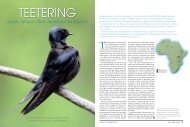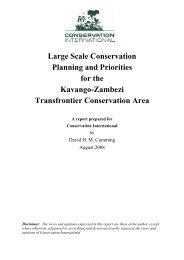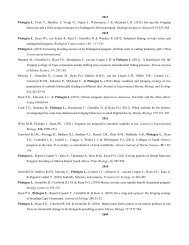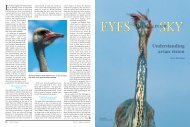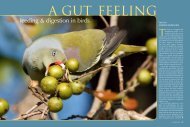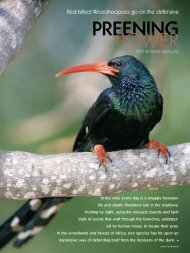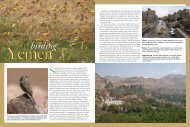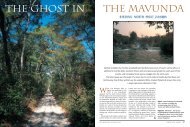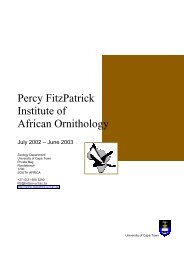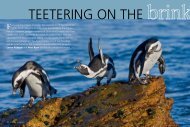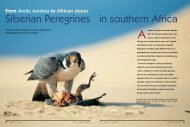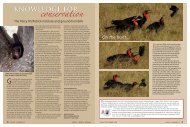Complete Handbook - Percy FitzPatrick Institute of African ...
Complete Handbook - Percy FitzPatrick Institute of African ...
Complete Handbook - Percy FitzPatrick Institute of African ...
- No tags were found...
You also want an ePaper? Increase the reach of your titles
YUMPU automatically turns print PDFs into web optimized ePapers that Google loves.
conservationbiologyM.Sc. Course <strong>Handbook</strong>UNIVERSITY OF CAPE TOWN
The <strong>Percy</strong> <strong>FitzPatrick</strong> <strong>Institute</strong> is recognised as a Centre <strong>of</strong>Excellence by the South <strong>African</strong> Department <strong>of</strong> Science and Technologyand the National Research Foundation. It is part <strong>of</strong> the Department <strong>of</strong>Zoology at the University <strong>of</strong> Cape Town (UCT), with a focus on researchand post-graduate education. Although the <strong>Institute</strong> focuses primarilyon ornithological research, the Conservation Biology MSc Programme isbroad-based, drawing on teaching expertise from across the academicspectrum at UCT and further afield.Nestled on the slopes <strong>of</strong> Devil’s Peak, UCT overlooks the cosmopolitancity <strong>of</strong> Cape Town. It is South Africa’s oldest university, and is one <strong>of</strong>Africa’s leading teaching and research institutions. It has more than15 000 undergraduate and 6000 post-graduate students, and attractsa large number <strong>of</strong> international students, with more than 4000 studentsfrom over 100 countries.UCT has a strong tradition in conservation research. Situated in theheart <strong>of</strong> the Cape Floristic Kingdom, it is well placed for research in twoglobal biodiversity hotspots, the Fynbos and the Succulent Karoo. In a2008 review, UCT ranked top among Southern Hemisphere institutionsin terms <strong>of</strong> the impact <strong>of</strong> its conservation research, equivalent to thefourth-placed institution in North America.conservationconservation biologybiologyM.Sc. Course <strong>Handbook</strong>2 Introduction2 Who is elegible to entrol?3 Structure <strong>of</strong> course4 Coursework outline6 Selection criteria6 Checklist for applicantsCONTENTS OF COURSE8 Introduction9 Ecological coreBiodiversity and the units <strong>of</strong> conservationDemography and population viability analysisCommunity EcologyEcosystem and aquatic ecologyConservation geneticsDisturbance and restoration ecologyInvasive species19 Interdisciplinary coreComplex systemsLandscape ecologyClimate change and conservationResource ecologySocieties and natural resourcesDecision analysis for conservation biology24 SynthesisInformation for international studentsUNIVERSITY OF CAPE TOWN
introductionConservation biology is thestudy <strong>of</strong> how best to sustainand manage linked systems <strong>of</strong> peopleand nature. It is a new sciencethat builds on a range <strong>of</strong> existingdisciplines, ranging from ecologyaims &objectivesOur teaching philosophy followsthe observation <strong>of</strong> William ButlerYeats: “Teaching is not the filling <strong>of</strong>a bucket, but the lighting <strong>of</strong> a fire”.The general aims <strong>of</strong> the ConservationBiology MSc programme are to producegraduates with a broad understanding<strong>of</strong> conservation issues andto provide them with the scientificbackground and tools to be able toanalyse and solve practical, conservation-relatedproblems. A synthetic,holistic approach is encouraged toproblem solving through exposure toa variety <strong>of</strong> disciplines. Emphasis isalso placed on developing oral andwritten communication skills. Wehave found that this broad approachto postgraduate education producesgraduates who compete successfullyin the job market and go on to makea difference in the field. Althoughemphasis is given to solving conservationchallenges in an <strong>African</strong>context, students are provided witha broad-based education that willstand them in good stead throughoutthe world. In 2007, in a study publishedin Conservation Biology, theUniversity <strong>of</strong> Cape Town was rankedequivalent with the fourth highestNorth American institution in terms <strong>of</strong>the impact <strong>of</strong> its conservation-relatedresearch publications.and evolution to sociology andeconomics. Conservation biologyis becoming increasingly importantfor human wellbeing as the impacts<strong>of</strong> human activities on the biospherebecome more significant.A programme in ConservationBiology was established at the<strong>Percy</strong> <strong>FitzPatrick</strong> <strong>Institute</strong> in 1991 toeducate students and conservationpractitioners in the fast developingfield <strong>of</strong> conservation science. The<strong>FitzPatrick</strong> <strong>Institute</strong> is housed withinthe Department <strong>of</strong> Zoology in theFaculty <strong>of</strong> Science at the University<strong>of</strong> Cape Town. The Fitztitutepromotes and undertakes scientificstudies, mainly involving birds thatcontribute to the theoretical andpractical development <strong>of</strong> ecology,evolution, and conservation biology.The central focus <strong>of</strong> the conservationbiology programme at the Fitztituteis an intensive MSc degree comprising7 months <strong>of</strong> coursework and a6-month individual research project.South <strong>African</strong> society has beenthrough a set <strong>of</strong> massive changesin the last 20 years; much <strong>of</strong> the resultingdynamism and openness tonew ideas is mirrored in South <strong>African</strong>conservation. The discipline<strong>of</strong> conservation biology is undergoinga similar paradigm shift, inwhich notions <strong>of</strong> preservation andpaternalism are being replaced byan ethic that recognizes the complexity<strong>of</strong> linked social and ecologicalsystems and the critical needfor solid interdisciplinary research.The <strong>Percy</strong> <strong>FitzPatrick</strong> <strong>Institute</strong> iscontributing to this disciplinarytransformation through researchand teaching, while also collaboratingwith others to support sound,action-oriented science.who is eligible to enrol?Applicants to join the coursemust hold at least a BSc Honours(or equivalent qualification).Applicants will be drawn mainlyfrom two groups: young people whohave just obtained a degree and wishto become conservation biologists,and qualified, practising natureconservators who wish to updateand/or expand their knowledge <strong>of</strong>the modern theory and practice <strong>of</strong>conservation biology. The course isan intensive one, and only a limitednumber <strong>of</strong> participants are acceptedeach year. Details regarding registrationfees, and approximate accommodationand living expenses inCape Town are available on request.Prospective applicants should applyto the Director, <strong>FitzPatrick</strong> <strong>Institute</strong>,University <strong>of</strong> Cape Town, Rondebosch, South Africa 7701. Applicationsmust reach this address before the end <strong>of</strong> August each year to beconsidered for a place on the course the following year. Applicants fromoutside South Africa are encouraged to apply early so that they haveplenty <strong>of</strong> time to apply for funding and study visas. Applicants shouldplease consult the Checklist for Applicants for the relevant documentsand information that must accompany applications.structure <strong>of</strong> the courseThe coursework component isintensive and exacting, butrepresents a huge learning opportunityand the chance to interact witha wide range <strong>of</strong> excellent conservationbiologists, both within andoutside the university environment.It includes 7 months <strong>of</strong> intensivecoursework and a 6-monthindividual research project.Coursework consists <strong>of</strong> a series<strong>of</strong> modules, each taught by expertsin their field. Modules typicallyinclude lectures, practicals,essays, discussion groups, semi -nars and field excursions. Readinglists are provided. Emphasis isplaced on <strong>African</strong> examples andcase histories.Appropriate computer coursesare available for participants whodo not have the relevant skills,but applicants are encouraged todevelop at least rudimentarycomputer skills before enrolling.The <strong>Institute</strong> has excellent computerand library facilities.Modules fall into four differentsections: an introduction, an ecologicalcore, an interdisciplinary core,and a synthesis. Each module lastsbetween one and four weeks.The introduction occupiesthe first three weeks and includesorientation, an overview <strong>of</strong> conservationbiology, and a week studyingthe philosophy <strong>of</strong> science.The ecological coreincludes modules in communityecology, population ecology,biodiversity basics, aquaticecology, molecular ecology,disturbance and restorationecology, and invasion biology.The interdisciplinarycore includes modules incomplex systems concepts,landscape ecology and conservationplanning, climate change,resource economics, andsocieties and natural resources.The synthesis sectionconsists <strong>of</strong> a section on decisionsupport systems, discussion<strong>of</strong> “emerging issues” and areview <strong>of</strong> the course.Modules are complementedby regular Wednesday afternoonseminars, which cover additionaltopics and provide students withthe opportunity to meet currentconservation practitioners. Thecoursework component <strong>of</strong> thecourse starts in mid-January andthe modular component is completedby the end <strong>of</strong> August.From September to mid-February,students conduct and write upresearch culminating in a paper on aresearch topic chosen by the studentand supervised by a member <strong>of</strong> academicstaff. The research report is inthe format <strong>of</strong> a manuscript suitablefor publication, which should facilitatethe dissemination <strong>of</strong> results. It mustbe stressed that these researchreports are not equivalent to dissertationsproduced for the award <strong>of</strong> anMSc based on a thesis alone.Modules are examined in April-May and August. Exams are ‘openbook’, and emphasize the solving<strong>of</strong> practical problems with a fullrange <strong>of</strong> resources available to students.The MSc degree is awardedto students who achieve grades inexcess <strong>of</strong> 50%, and is awarded withdistinction if grades exceed 75%for both the coursework and projectcomponents <strong>of</strong> the course. There isa minimum requirement for the firstexamination to allow students tocontinue with the course.2 | conservation biology university <strong>of</strong> cape town | 3
selection criteriaWe accept only 12-14 studentseach year into the conservationbiology masters programme.There are <strong>of</strong>ten 2-3 times this manyapplicants each year, resulting incompetition for places. In additionto academic ability, preference isgiven to candidates with experiencein the conservation arena,particularly in an <strong>African</strong> context.Because <strong>of</strong> the intensive nature <strong>of</strong>the programme, students spenda lot <strong>of</strong> time working closely withtheir peers. Having students from adiversity <strong>of</strong> backgrounds contributessignificantly to the success <strong>of</strong>the programme. Consequently westrive each year to select studentsthat combine a mix <strong>of</strong> youthful enthusiasmand mature experience, aschecklist for applicantswell as a mix <strong>of</strong> students from firstand third world countries. The idealclass comprises roughly one thirdstudents from South Africa, onethird from the rest <strong>of</strong> Africa, andone third from the rest <strong>of</strong> the world.Since its inception, almost 200students have graduated from theCB programme from more than 30countries.Applicants to the course, please check that you include all the following documents and information with yourapplication. Please note that applications must reach the <strong>Percy</strong> <strong>FitzPatrick</strong> <strong>Institute</strong> by the end <strong>of</strong> August to beconsidered for the following year.contents <strong>of</strong> course1. Letter <strong>of</strong> application to the Director, <strong>FitzPatrick</strong> <strong>Institute</strong>.2. Full Curriculum Vitae giving permanent address and telephone/fax numbers, date <strong>of</strong> birth, full names, nationality,educational history up to present date, employment history (if any) up to present date, details <strong>of</strong> computer systemsand s<strong>of</strong>tware packages used to date, and details <strong>of</strong> any research publications.3. Names, addresses, fax numbers, telephone numbers and e-mail addresses (if possible) <strong>of</strong> at least two refereeswho can comment on your academic ability, suitability for postgraduate study, and also give a confidential personalevaluation <strong>of</strong> your sense <strong>of</strong> initiative and computer literacy.4. Undergraduate academic transcript showing marks for each course taken in each year. This should be a photocopy<strong>of</strong> the original, but the photocopy should have an original stamp certifying that it is a true copy <strong>of</strong> the original transcript.Certified copies <strong>of</strong> transcripts <strong>of</strong> any subsequent postgraduate qualifications should also be included here.5. A certified copy <strong>of</strong> the original degree certificate (and any subsequent qualifications mentioned above).6. A summary (1-2 pages, typed) outlining why you chose to apply for a place on the CB Course, what your long-termcareer aspirations are, and how you think the successful completion <strong>of</strong> the CB Course will benefit those aspirations.7. <strong>Complete</strong>d UCT admission forms (with the admission fee). This will be kept at the <strong>FitzPatrick</strong> <strong>Institute</strong> until theresults <strong>of</strong> the Selection Committee are known. If successful, the forms (and fee) will then be sent to UCT CentralAdmissions Office for processing. This saves approximately one month in postal lags at a time when prompt communicationbecomes vital. Copies <strong>of</strong> UCT admission forms are available on request.8. Please provide the <strong>Percy</strong> <strong>FitzPatrick</strong> <strong>Institute</strong> with details about where you are applying for funding. If appropriate, a letter<strong>of</strong> support can then be sent to them (if your application for a place is successful) to strengthen your funding application.Address your application (or any queries) to:The Director, <strong>FitzPatrick</strong> <strong>Institute</strong>, University <strong>of</strong> Cape Town,Private Bag X3, Rondebosch 7701, South AfricaTel. (+27-21) 650 3290/1, fax (+27-21) 650 3295or e-mail the course coordinator at peter.ryan@uct.ac.za6 | conservation biology university <strong>of</strong> cape town | 7
apted genomes by genetic materialfrom translocated conspecifics(known as outbreeding depression),and the loss <strong>of</strong> genetic variationthrough failure to conserve geneticallydistinct geographical variants.BiogeographicalcomponentsBiodiversity can be representedby other factors (e.g. endemicity,rarity, degrees <strong>of</strong> species turnoverbetween adjacent biotopes andbetween similar, but geographicallyisolated biotopes). These need tobe identified and assessed. One <strong>of</strong>the most important biogeographicalquestions to be addressed iswhether there are indicator species(regardless <strong>of</strong> their need forconservation) whose survival is astrong predictor <strong>of</strong> the continuedpersistence <strong>of</strong> acceptable levels<strong>of</strong> biodiversity. Biogeographicalassessments rely heavily onmultivariate numerical approaches.Throughout the methodologicalportion <strong>of</strong> this module, the emphasiswill be placed on the types <strong>of</strong>data which need to be collected andthe analytical approaches necessaryto transform those data into meaningfulsummaries. The mathematicaland statistical theory underpinningthe approaches employed willbe discussed.Socioeconomic componentsBiodiversity can be represented by the variety <strong>of</strong> plants and animalsneeded by human societies for economic, agricultural, medicinal, culturaland hunting purposes. Many organisms also have symbolic value forman, which is reflected in their existence value.Production <strong>of</strong> biodiversityThe ultimate processes whichcreate evolutionarily significantvariation are genetic mutation andrecombination. The ultimate processeswhich partition that variationinto the units <strong>of</strong> conservationare subspeciation (geographicalvariation) and speciation (usuallyvia reproductive isolation). Thismodule focuses on processeswhich promote subspeciation(e.g. selective gradients andpartitioning <strong>of</strong> populations bybiogeographical barriers), speciation(e.g. sympatric, parapatric,peripatric and allopatric) andhybridization.demography and population viability analysisAssessing extinction risk is acore goal <strong>of</strong> conservationists.This module considers the variousfactors, both stochastic (demographic,genetic and environmental)and deterministic (extrinsicfactors such as exploitation, habitatloss, etc.) that combine to renderpopulations and species vulnerableto extinction within the framework<strong>of</strong> Caughley’s small population anddeclining population paradigms.The module starts by tracing thehistory <strong>of</strong> the field, starting withthe holy grail <strong>of</strong> a Minimum ViablePopulation, moving through theinitial optimism regarding PopulationViability Analysis as a quantitativetool, to the current positionwhere demographic models areseen as valuable tools to supportqualitative management decisionrather than providing an absolutemeasure <strong>of</strong> extinction risk. Mirroringthis attitudinal shift are changesin the IUCN Red Listing criteria.Demography is the study <strong>of</strong>the age-specific rates <strong>of</strong> fertilityand mortality, which determinewhether a population or species isincreasing, decreasing, or remainingstable. Change in populationsize is determined by the balancebetween birth and death rates.From the starting point <strong>of</strong> simple,deterministic Malthusian and“Assessing extinctionrisk is a core goal <strong>of</strong>conservationistslogistic growth models, we add agestructure and derive Leslie matrixmodels which are a useful startingpoint for any demographic investigation.We consider the family <strong>of</strong>Leslie matrices that describe pulsedreproduction in populations, andtouch on the possibility <strong>of</strong> continuousreproduction. Concepts suchas stable growth rate, stable agedistribution, reproductive valueand elasticity are explained andused to understand how populationsperform. We then buildsimple harvesting or supplementationmodels, and consider the imposition<strong>of</strong> density dependence onage-structured models. Populationstypically are in a state <strong>of</strong> dynamicequilibrium, driven by intrinsicand extrinsic stochastic events. It isimportant to distinguish shorttermfluctuations from shifts in theequilibrium, but this is <strong>of</strong>ten hardto achieve in practice.”Estimating populationparametersBuilding demographic models isfairly easy. The hard part is populatingthem with robust demographicparameters. Even simple, deterministicage-structured demographicmodels require a large amount <strong>of</strong>information. At a minimum oneneeds age-specific survival andfecundity estimates, but these entaila wealth <strong>of</strong> complexity. Survivalmay differ with sex and status (territoryholder vs floater), whereasfecundity depends on the age atfirst breeding, the proportion <strong>of</strong>mature individuals that attempt tobreed and the frequency <strong>of</strong> reproductionas well as crude birth rateand breeding success. Estimatingdemographic parameters typicallyrequires that a large sample <strong>of</strong> individualsbe individually-marked andtheir fates followed. In most cases,maximum-likelihood techniqueshave to be used to simultaneouslyestimate apparent survival andrecapture probabilities. We havea brief introduction to these techniquesin MARK. Depending onthe distribution <strong>of</strong> sampling effort,following marked individuals mayalso give some idea about rates <strong>of</strong>emigration and dispersal distances.There are problems dealing withvery old individuals, because to<strong>of</strong>ew marked animals attain oldages to allow robust parameterestimation. Students are alertedto the limitations <strong>of</strong> estimatingparameters, and encouraged to becritical <strong>of</strong> input data when assessingpublished models.Estimating population sizeThe other parameter that needsto be estimated is population size.This requires a defensible definition<strong>of</strong> a population (geographically, geneticallyor both). We have a quick10 | conservation biology university <strong>of</strong> cape town | 11
efresher <strong>of</strong> census techniques formobile and sessile organisms., andconsider the difference betweensampling error and population fluctuations.In many cases there aresimply insufficient data to constructa demographic model. The best wecan do is look for trends in populationsize over time, bearing in mindthat changes in the size <strong>of</strong> a populationmay occur through changes inits range, density, or both. Simpleregression analysis can be used totest for a population trend. However,if a significant trend is notdiscovered, we need to estimate thepower <strong>of</strong> the test. This is dependenton the length <strong>of</strong> the data series,the magnitude <strong>of</strong> the hypothesisedrate <strong>of</strong> change (either linear orexponential) and the coefficient <strong>of</strong>variation <strong>of</strong> the initial populationestimate. We use Tim Gerodette’sprogramme TRENDS to solve thistricky puzzle. In some instancesthe precision <strong>of</strong> the populationestimate may be so poor that it isnot possible to detect a change inpopulation size until it is too late.Under these circumstances, othermanagement techniques have to beemployed to assess the health <strong>of</strong> apopulation.Adding stochasticity –Population VulnerabilityAnalysisAdding stochasticity to demographicmodel adds a sense <strong>of</strong>realism by allowing one to explorea range <strong>of</strong> possible outcomesrather than a single, deterministicoutcome. This lends itself to theconcept <strong>of</strong> extinction risk, giventhat extinction <strong>of</strong>ten appears to bea stochastic process. Populationviability analysis (PVA) modelsattempt to assess the probability<strong>of</strong> a population <strong>of</strong> a given sizebecoming extinct within a specifiedtime frame under a definedset <strong>of</strong> possible future conditions.In conservation, we are <strong>of</strong>tenmore concerned with exceptionalpopulation behaviours rather thanthe average. The range and distribution<strong>of</strong> individual variationin demographic performance isespecially critical in the dynamics<strong>of</strong> small populations. Giventhe limited time available for thismodule, we use VORTEX, a packagedesigned to predict extinctionrisk in small animal populationsusing an individual-based, stochasticsimulation. Students eachconduct a PVA based on real datausing VORTEX.Spatially explicit modelsAdding spatial structure adds furtherrealism, but brings with it aheavy price in terms <strong>of</strong> additionaldata demands (and concomitantloss <strong>of</strong> model power). We considerspatially-explicit differences in demographicparameters, resultingin source and sink areas, as well asthe concept <strong>of</strong> meta-populations,with movement between habitatpatches. To build a spatially-explicitmodel, one needs patch-specificsurvival and fecundity data,as well as information on movementrates, and associated risks<strong>of</strong> mortality, between patches as afunction <strong>of</strong> age, sex and status.An introduction tomodellingThis module also introducesstudents to numerical modelling.A model is a simplified representation<strong>of</strong> an object, and canbe explanatory or predictive. Inthe former case, models help t<strong>of</strong>ormalise our understanding <strong>of</strong>a system and to highlight gapsin our knowledge. Such modelsdeliver qualitative rather thanquantitative data, but can still beuseful in guiding managementactions, in addition to directingfuture research efforts.Explanatory models also can beused to build null models and testthe significance <strong>of</strong> patterns observedin nature. Predictive modelstend to be more demanding ondata, and great caution needs tobe exercised in translating resultsfrom the simplified model worldinto the real world. The type <strong>of</strong>model used depends primarily onthe question being asked and, to alesser extent, the amount <strong>of</strong> dataavailable. Students are exposedto deterministic and stochasticmodels, as well as population andindividual-based models.community ecologyCommunity ecology is a complexsubject that fuels muchdebate in the scientific literature.Frequently, classical theories haveproved inadequate to explainpatterns observed in nature. Thesearch for paradigms has becomeconfounded by exceptions, and thedream <strong>of</strong> a unifying theory withglobal application is far from beingrealized. Escalating anthropogenicdisturbance and exploitation <strong>of</strong> thenatural environment have highlightedthe importance <strong>of</strong> communityecology theory to conservationbiologists. There is an ever-increasingemphasis on predicting theecological consequences <strong>of</strong> certainactions; such prediction is not possiblewithout an understanding <strong>of</strong>community dynamics.This module provides anoverview <strong>of</strong> recent thinking aboutcommunity structure and dynamics,and <strong>of</strong> the theoretical and empiricalbases that have underpinnedmodern concepts in the field. Thefirst week <strong>of</strong> the 2-week module isdevoted to theoretical considerations,and the second week is spentin the field examining how theseideas can be translated into problemsolving. Underlying the entiremodule is the theme that definescommunity ecology, from identifyingpattern, to inferring processesand making predictions.The theoreticalbackgroundThe theoretical component startsby addressing the factors andforces that structure communities.This theme is developed furtherthrough an exploration <strong>of</strong> communitystructure and stability, andexamining how the way in whichpattern is investigated will affectthe interpretation <strong>of</strong> structure andstability, and organization andcomplexity. We explore food webstructure, with particular emphasison how community connectednessand compartmentalization affectcascades within communities. Weconsider why surviving interactionswithin communities are highlynon-random and address the questions<strong>of</strong> whether different communities,containing different species,are functionally convergent.A factor underlying many elements<strong>of</strong> conservation biology isscale – this is <strong>of</strong> paramount importancewhen considering patterns <strong>of</strong>species abundances and scales <strong>of</strong>diversity. We consider how communitiesare structured in terms<strong>of</strong> their relative species’ abundances,and why. This incorporatesspecies-abundance patterns,Island Biogeography Theory andan investigation <strong>of</strong> the differencesbetween inventory and differentiationdiversity concepts.Diversity, however, can changeover short time scales either as aresult <strong>of</strong> intrinsic processes suchas migration, or extrinsic forcingfactors such as environmentalcrunches and climate change. Weconsider these variations and theirimplications, and also address thequestion <strong>of</strong> whether communitiesare saturated.Modern conservation biologistsare concerned about rapid changesin species’ distribution patterns andthe degree to which these are forcedby anthropogenic factors. We examinepatterns <strong>of</strong> distribution andendemism and explore why many<strong>of</strong> these apparently fail to conformto theoretical predictions. This inturn leads to consideration <strong>of</strong> thefactors that drive local or regionalvariation in species’ densities.To round <strong>of</strong>f the theoreticaltreatment <strong>of</strong> community ecology,we revisit two old ‘chestnuts’ –niches and guilds, and the thorny12 | conservation biology university <strong>of</strong> cape town | 13
issue <strong>of</strong> competition as a forcestructuring communities. In terms<strong>of</strong> niches and guilds, we concentrateon how to decide when theyare useful as concepts, and in thecase <strong>of</strong> competition, emphasis isplaced on distinguishing betweenintensity and importance.In most years, the week <strong>of</strong> theorywill include lectures from at leasttwo specialists: in 2008 these includeda guest lecture about the forcesstructuring diversification in batcommunities, one which exploredthe importance <strong>of</strong> food-web modellingin managing marine ecosystemsand a third which addressed theinteractions between competition,predation and trophic cascades.The field componentThis is the time for putting theoryinto practice! By way <strong>of</strong> example,the following field problems weretackled in recent years.• Why has a dominant alien marinecompetitor has failed to removea competitive subdominant fromthe shore?• How does fire influences the interactionbetween fynbos and forestand how does this affect managementdecisions?• Alien plant clearance program mes:why do the ‘recovering’ plant communitiesdiffer so dramatically anddoes this influence how alien clearanceprogrammes should operate?• Why is a rare, indigenous bird thrivingonly in disturbed, alien infestedriverine forests?• What will the Orange Klo<strong>of</strong> forests(heavily selectively logged by earlysettlers) look like in 150 yearstime?ecosystem & aquatic ecologyInland aquaticecosystemsThis 1-week module serves as anintroduction to inland aquaticecosystems such as rivers, lakes,floodplains and wetlands, and thenfocuses on rivers because they arethe major target <strong>of</strong> water-resourcedevelopment. As the end-point<strong>of</strong> drainage in the landscape,inland water systems have no trueboundaries and are highly vulnerableto disturbance occurringanywhere within the landscape.Additionally, because they are thesource <strong>of</strong> most <strong>of</strong> the world’s freshwater, massive landscape-scalemodifications <strong>of</strong> their flow regimesto suit human needs result in widespreadand severe degradation <strong>of</strong>the rivers themselves. In developingcountries, hundreds <strong>of</strong> millions<strong>of</strong> people are subsistence users<strong>of</strong> rivers and the developmentdrivenchanges generally impactthem most whilst the advantages<strong>of</strong> development are felt elsewhere,such as in cities. As we enter a newera <strong>of</strong> dam building that is focusedon developing countries, improvedand more sensitive developmentand management <strong>of</strong> the world’srivers is vital, for we are now <strong>of</strong>tenlosing more than we gain fromwater developments.The module covers the natureand functioning <strong>of</strong> river ecosystems,the impacts <strong>of</strong> developmenton them and their subsistenceusers, and modern moves towardintegrated water resource management(IWRM) that incorporatesocial and ecological issues atthe same level <strong>of</strong> importance asengineering and economic issues.Students will be introduced to thewide range <strong>of</strong> disciplines involvedin IWRM with explanations <strong>of</strong>their role: hydrology, hydraulics,geomorphology, sedimentology,water chemistry, bank and channelvegetation, aquatic invertebrates,fish and fisheries, aquatic andwater-dependent mammals, waterbirds, resource economics, macroeconomics,sociology, public andlivestock health, and intangiblecultural and religious issues. Othertopics covered include the goodsand services provided by rivers,scenario creation, modern DecisionSupport Systems (DSS) and how todeal with data-poor situations.Written and other research tasksand discussion groups focus onriver and catchment signatures(the unique species composition <strong>of</strong>aquatic and riparian plant and animalcommunities in each river); thenature <strong>of</strong> and threats to a selection<strong>of</strong> the world’s Great Rivers, how tocommunicate with engineers andpolitical decision makers, and howto approach river management witha conservation perspective.Marine systemsThe science <strong>of</strong> conservationbiology has until recently beenconcerned almost exclusively withterrestrial biodiversity and landscapes.This is changing rapidly,but the application <strong>of</strong> terrestrialparadigms and experience in themarine environments is inappropriate.Food web-structure, reproductivesystems, dispersal, biogeography,the nature <strong>of</strong> threats,property rights and human valuestogether dictate a new approach toconservation <strong>of</strong> the sea.Human-induced extinction <strong>of</strong>marine species is extremely rare.Is this statement correct, and if so,why? The criteria used to list speciesas threatened or critical differbetween land and sea. Fishingis regarded as the greatest threatto marine biodiversity. Fisheriesmanagement and marine conservationshould be synonymous, but inpractice the underlying philosophiesdiffer widely. How are theybeing reconciled? There is widespreadevidence <strong>of</strong> severe depletion<strong>of</strong> fish stocks by fishermen. Boomand bust is the norm for almostevery fishery. Why are these trendsuniversal, even where fisherymanagement and marine scienceis well-funded? The cessation <strong>of</strong>fishing and marine protected areasare argued by many to hold theanswer to stock recovery, but suchremedies are difficult to implementand may have unexpected andundesirable consequences.This module investigates theecology <strong>of</strong> marine organisms, particularlythose targeted by fisheries.Debates between fishery managersand conservationists usually hingeon the interpretation <strong>of</strong> poor datawith low statistical power, andsophisticated mathematical andstatistical models. Conservationistsare frustrated by the lack <strong>of</strong>progress in the application <strong>of</strong> effectiveconservation measures. Thismodule examines some the social,economic and political processesthat have led to the deplorable state<strong>of</strong> many marine ecosystems, andconsiders alternatives.There has been a massive recentpush for the application <strong>of</strong> MarineProtected Areas. This conservationstrategy has gained many localisedsuccesses, mostly in coastal waters,but their application in <strong>of</strong>fshoreenvironments and the high seasremains problematic. In addition,there is much disagreement overthe value <strong>of</strong> such areas to fisheries.This module considers the processesby which marine protectedarea sites are selected and designed,and considers the circumstances inwhich they may be useful. Otherforms <strong>of</strong> regulation are also considered,including the controversialpractice <strong>of</strong> re-stocking.Fish farming is seen by manyas a relief for wild stocks, and ananswer to the insatiable demand forseafood. Salmon has changed froma king’s delicacy to the chicken <strong>of</strong>the sea. We look at the ecological,social and economic realities<strong>of</strong> replacing wild caught fish withfarmed products.conservationgeneticsThe subject <strong>of</strong> ConservationGenetics merges a number<strong>of</strong> biological disciplines includingecology, molecular biology, mathematicalmodeling and evolutionarysystematics. It is both a theoreticaland an applied science; theoreticalapproaches include those <strong>of</strong> classicPopulation Genetics, the emergingtheories <strong>of</strong> Phylogeography, andPhylogenetic Systematics.Population genetics is concernedwith the application <strong>of</strong> geneticprinciples, such as Mendel’s laws, toentire populations and attempts tounderstand evolutionary mechanismsat this level. An applicationis found in conservation biologywhich is ultimately concernedwith maintaining the evolutionary14 | conservation biology university <strong>of</strong> cape town | 15
potential <strong>of</strong> species, not simply thepreservation <strong>of</strong> reasonable numbers<strong>of</strong> individuals. To achieve this weneed to know the amount anddistribution <strong>of</strong> genetic variation ina species or population and, moreimportantly, to understand theunderlying processes generatingsuch patterns.Classical population genetics,whether theoretical or empirical,focuses on the analysis <strong>of</strong> genefrequencies. Additionally, analysis<strong>of</strong> non-nuclear genes (mitochondrialor chloroplast), non-selectedportions <strong>of</strong> the genome (DNAfingerprinting) and the determination<strong>of</strong> direct DNA sequenceshave brought the fields <strong>of</strong>population genetics and molecularsystematics closer together. Theemerging field <strong>of</strong> phylogeographyprovides a platform for analysingDNA sequence data within aspatio-temporal framework, whilemolecular systematics informs ourunderstanding <strong>of</strong> the evolution<strong>of</strong> animal and plant lineages; inso doing these approaches helpdetermine ‘units <strong>of</strong> conservation’;these can be populations, species,ecotypes, morphotypes etc. Thismodule covers the essentials <strong>of</strong>both evolutionary and moleculargenetics with the emphasis on therelevance <strong>of</strong> each component tospecies in the wild. Attention isalso given to investigating adaptivegenetic variation, quantitativegenetics and the inheritance <strong>of</strong>measurable morphological traits(especially fitness).Theoretical andstatistical aspectsConservation genetics aims toderive strategies for the long-termmaintenance <strong>of</strong> the genetic variability<strong>of</strong> species, since genetic variabilityis intimately linked to both therelative fitness <strong>of</strong> each individualand the long-term adaptability andevolutionary potential <strong>of</strong> the population.Understanding the basis forthis variability (and hence fitness)requires knowledge <strong>of</strong> the inheritance<strong>of</strong> genes, gene frequencies inPractical applications <strong>of</strong> population geneticsWhereas mutation is the ultimate source <strong>of</strong> all genetic variation, manyother factors determine the distribution and maintenance <strong>of</strong> this variation.These factors include sexual reproduction, natural selection (and unnaturalin captive populations), migration, and genetic drift in isolated populations.Population bottlenecks may contribute to inbreeding, with consequent implicationsfor fitness (inbreeding depression).The counterpart to this is outbreeding depression which can occur as a consequence<strong>of</strong> moving individuals into the ranges <strong>of</strong> other populations <strong>of</strong> theirspecies and also by mixing captive populations from different sources. Bothhave significant implications for conservation management, especially in theuse <strong>of</strong> concepts such as effective population size and population viability.populations, how selection actson the genome and the way theseaspects are described by the Hardy-Weinberg Equilibrium model.Molecular evolutionSince many <strong>of</strong> the most effectivetechniques for measuring andquantifying genetic variability arebiochemical, an understanding<strong>of</strong> the molecular basis <strong>of</strong> geneticsand evolution is required. Thisconsists <strong>of</strong> the structure <strong>of</strong> theeukaryotic genome and <strong>of</strong> the geneticmaterial (DNA) itself. In addition,some details <strong>of</strong> the DNA <strong>of</strong>sub-cellular organelles such as mitochondriaand chloroplasts (sincethey are <strong>of</strong>ten the easiest to studyin practice) must be considered.The various types <strong>of</strong> mutationalevents are discussed to show howthe genome and the organismevolve, and to explain conceptssuch as that <strong>of</strong> neutral evolution(which describes changes in thegenotype that have insignificantconsequential changes in thephenotype), adaptive evolutionand the so-called molecular clock(whether molecular changesin DNA occur, on average, at aconstant rate).Computer modelling <strong>of</strong>population genetic dataThere are few better ways to gainunderstanding and insight intoconceptual problems than throughinteractive computer modelling.A number <strong>of</strong> computer-basedprograms in population and moleculargenetics are demonstratedto participants. These will provideexercises blending both theoreticaland practical aspects <strong>of</strong> populationand molecular genetics.disturbance & restoration ecologyThis two-week module is verypractical and participatory. Itcomprises three sections – theory,fieldwork and a written assignment.The 4-day theoretical introductioncovers concepts and theoriesin the disciplines <strong>of</strong> disturbanceecology and restoration ecologythrough a mixture <strong>of</strong> lectures,discussions and student seminarsbased on key papers. The concept<strong>of</strong> disturbance includes events thatdisrupt ecosystem, community, orpopulation structures and changeresources, substratum availabilityor the physical environment. Bothnatural and anthropogenic disturbancesand disturbance regimesare considered, together with theirroles in evolution <strong>of</strong> life-historytraits, the structuring <strong>of</strong> plant andanimal populations and communities,and their influences onecosystem functioning. Ecologicalrestoration is the process <strong>of</strong> assistingthe recovery <strong>of</strong> biodiversityand/or functions <strong>of</strong> an ecosystemthat has been degraded, damaged,or destroyed. Restoration is linkedwith disturbance ecology throughits focus on damaged environmentsand through the use <strong>of</strong> managementinterventions to restore species,populations or functions.During the 4-day field trip,hypotheses relating to the applications<strong>of</strong> disturbance in conservationmanagement and restorationare tested. The field data are thenanalysed and a scientific paper preparedfor assessment. Skills developedor strengthened include thedesign <strong>of</strong> field experiments, use <strong>of</strong> avariety <strong>of</strong> methods for quantifyingdisturbance, vegetation cover, plantpopulation structure and habitatheterogeneity, data and metadatacompilation, critical review <strong>of</strong> publishedliterature, presentation andevaluation <strong>of</strong> mini-lectures and theart <strong>of</strong> scientific writing.An understanding <strong>of</strong> disturbanceand restoration ecology is essentialfor a career in ecological impactassessment, habitat and populationmanagement, ecological restorationand rehabilitation, conservationplanning, or protected areadesign. Predicting the effects <strong>of</strong>management interventions suchas burning, fire exclusion, culling,bush clearing, selective harvesting,livestock reductions, and speciesintroductions requires a knowledge<strong>of</strong> disturbance ecology theoryas well as the knowledge gainedthrough practical experience.16 | conservation biology university <strong>of</strong> cape town | 17
invasive speciesThe view <strong>of</strong> Charles Elton thatundisturbed native communitiesare not susceptible to invasionby introduced species has blinkeredscientists to the realities <strong>of</strong> a veryserious conservation problem. Empiricalstudies have shown repeatedlythat this dogma is fallacious andthat, as a corollary, the phenomenonhas major implications for preservingbiodiversity. Now that the intellectualstalemate surrounding thetopic has been broken, it is apparentthat the scientific understanding<strong>of</strong> alien invasions is inadequate tomeet the challenges posed. Recentsyntheses and some novel researchhave allowed significant theoreticaladvances to be made. These aresufficient to increase markedly theeffectiveness <strong>of</strong> current programmesaimed at controlling invasives. Thismodule updates the level <strong>of</strong> currentecological understanding <strong>of</strong> invasionsand invasive species.Invasibility and itscorrelates/causesAbiotic determinants <strong>of</strong> the differentialsusceptibility <strong>of</strong> communitiesto invasion include disturbanceregimes and patterns <strong>of</strong> habitatdistribution within biomes. Bioticdeterminants <strong>of</strong> the success <strong>of</strong> invadersinclude ecological releasedue to the absence <strong>of</strong> host-specificparasites, diseases, predators and,for plants, herbivores found in theoriginal range; availability <strong>of</strong> appropriatepollinators and dispersersfor plants; the presence <strong>of</strong> generalistpredators and the level <strong>of</strong> competitionpresent in the invaded community.The greater susceptibility<strong>of</strong> island communities to invasion,compared to mainland ones, haslong been noted. Does this leadto valid generalizations about thecommunity structure <strong>of</strong> invadedcommunities?Invasiveness and itscorrelates/causesSo far it has proved impossible tomake well-founded predictionsabout which species will provesuccessful invaders and where. Thismeans that probabilistic techniqueshave to be used. One approach is totry and match the invader’s naturalrange characteristics with those <strong>of</strong>the area under consideration. Bioclimaticcharacters may be importanthere. Lifestyle characteristics mayalso be used but, so far, attemptedgeneralizations have broken downtoo <strong>of</strong>ten. Are there biogeographicand taxonomic patterns in invasiveness<strong>of</strong> species?impacts <strong>of</strong> invasionsThe impacts <strong>of</strong> invasions can beassessed on four geographicalscales: global, regional, biome andlocal. They also may be classifiedecologically. One <strong>of</strong> the problemsin such classifications is the timelag between arrival, first appearance<strong>of</strong> invasiveness and appearance <strong>of</strong>noticeable effects. It is clearly desirableto quantify invasive impacts,and techniques for doing so are discussed.It is possible to make somevalid generalizations on invasiveimpacts, with particular referenceto those related to biogeography,community structure and the priorevolutionary experience <strong>of</strong> invadedcommunities or ecosystems.Ecological basesfor controlIn dealing with biological invasions,the first point to attack is counteringthe effects <strong>of</strong> the invader’s ecological‘release’ from competitors, predators,parasites and pathogens. Thisis where biological control, properlymanaged, is invaluable. It may bepossible to manipulate the structure<strong>of</strong> the native community to makeit less susceptible to invasion. Oneway <strong>of</strong> doing this is to restore thedisturbance regime within whichthe community evolved. Globalclimatic change may hinder thisaim. Clearly, it is necessary to studyinvaders both demographically andecologically to ascertain where theweakest points are in the life cycle.Successful control programmes areusually characterized by integratedattacks at several weak points.Modelling invasionsand their controlThe use <strong>of</strong> models greatly improvesunderstanding <strong>of</strong> invasions and howto deal with them, whether they aremodels <strong>of</strong> the invasion process orones explaining invasive success.Demographic models are virtuallyessential for predicting the impacts<strong>of</strong> alternative control methods suchas biocontrol, disturbance regimemanipulations and integratedcontrol.interdisciplinary COREcomplex systemsThis one-week module <strong>of</strong>fers anintroduction to the study <strong>of</strong> complexsystems. Complexity presentsa challenge for many traditionalapproaches to understanding andmanaging ecosystems. At the sametime, it highlights the importance<strong>of</strong> people in management and theneed for approaches that take intoaccount not only the ecologicalaspects <strong>of</strong> conservation problemsbut also their human and societalaspects. The contents <strong>of</strong> the moduleare based loosely around the recentedited volume, Complexity Theory fora Sustainable Future (Norberg andCumming, 2008). Conservationrelevantcomplexity theory isconsidered in four transdisciplinarycategories: asymmetries, networks,information processing, and crosscuttingproblems such as scale andmanagement. Asymmetries refer tosystematic arrangements <strong>of</strong> systemelements and range from gradientsin landscapes through biodiversityto inequalities in livelihoods and differencesin power. Networks includeecological interactions, social interactions,physical connections suchas roads and railways, and informationnetworks such as radio and theinternet. Information processingin simple terms refers to whatoccurs between input and output,or between stimulus and response.In ecosystems it can include suchthings as the mechanisms by whichforest communities adapt to fragmentationor weeds evolve resistanceto herbicides; and in societies,it can include decision making andother political processes that influenceresponses to crises or opportunities.Lastly, questions about therole <strong>of</strong> system history, constraints,path dependencies and scale arisein each <strong>of</strong> these different realmsand influence empirical results andthe conclusions that are drawn fromthem about complex systems. Themodule includes explicit discussions<strong>of</strong> higher-order system propertiessuch as resilience and vulnerability,and illustrates how the growingfield <strong>of</strong> complexity theory providesa logical conceptual foundation forconservation biology.landscapeecologyThis four-week module coverskey concepts, skills andmethods, and conservation-relatedapplications <strong>of</strong> landscape ecologyand associated disciplines. Theconceptual content focuses on ways<strong>of</strong> thinking about spatial variation inthe biophysical and anthropogenicenvironments, and its role as both acause and a consequence <strong>of</strong> variationin ecosystems. Key topics includescale, hierarchy theory, pattern-processlinkages, landscape functionality,and adaptive management.The skills and methods component<strong>of</strong> the course aims to introducestudents to the tools that theywill need in order to undertake spatialanalyses <strong>of</strong> conservation-relatedproblems. The focus is on workingin a GIS (Geographic InformationSystem) environment and gettinguseful, synthetic information out <strong>of</strong>spatially explicit data sets. Most <strong>of</strong>the training in this area is undertakenthrough hands-on exercisesthat include interpreting aerialphotographs, completing simple18 | conservation biology university <strong>of</strong> cape town | 19
Irreplaceability index for areas <strong>of</strong> the Western Cape, as calculated by CBstudents Hannah Thomas, Jeremy Sheldon, Lindy McGregor, and DimbyRaharinjanahary. Green indicates current protected areas; urban centres areshaded purple; and different shades <strong>of</strong> red or grey indicate irreplaceability.operations in a GIS environment,working with remotely senseddata, calculating patch metrics, andspatial statistics. Students then applysome <strong>of</strong> these skills by workingin groups to develop a rudimentaryconservation plan for the WesternCape, using CLUZ and MARXANto prioritize areas.The applications component <strong>of</strong>the course takes conceptual andmethodological approaches andapplies them to real-world conservationproblems. These lecturesclimate change and conservationClimate change, compoundedby land-use change andother global problems, is one <strong>of</strong>the gravest environmental changedrivers causing biodiversity lossand changing species distributionsand abundances. This 1-weekmodule provides an introductoryoverview <strong>of</strong> key concepts, methodsand principles for the development<strong>of</strong> conservation approaches to helpgive most biodiversity “a fightingchance to survive the first (andmaybe the last) few centuries <strong>of</strong> theAnthropocene era.”Climate change impacts on,and vulnerability <strong>of</strong>, biodiversityare the emphasis <strong>of</strong> the module.We also focus on ways in whichhumans can maximize biodiversity’scapacity to adapt to climatechange through conservationaction, spatial planning and othermeans. Adaptation to climatechange is an emerging field <strong>of</strong>conservation biology, in whichfew hard and fast rules have beenrigorously tested. The urgency <strong>of</strong>the situation demands the wiseuse <strong>of</strong> flexible, dynamic conservationapproaches based onsound ecological and evolutionaryprinciples and a big-pictureview <strong>of</strong> human development andspecies evolution. The moduleis thus very interdisciplinary,and discussions cover such topicsas predicting species occurrences,alternative approaches to conservationplanning, difficulties inapplying landscape ecology ideas t<strong>of</strong>reshwater and marine ecosystems,the conservation <strong>of</strong> migratory species,and scenario planning.In general, the landscape ecologymodule introduces students to theanalysis <strong>of</strong> broad-scale problems.While the focus is on conservationrelatedtopics, broad-scale analysisinevitably introduces a wide range<strong>of</strong> other material; lectures touch ona variety <strong>of</strong> other disciplines andinclude ideas from economics, sociology,geography, and physics. Itis intended that students who havecompleted the module will havesufficient background to approachregional conservation problemsand planning efforts with a basicgrounding in theory, the abilityto work with spatial data, and ahealthy degree <strong>of</strong> skepticism.drawing on physiological tolerances,biogeography, systematicconservation planning, ecosystemmanagement, evolution, geneticsand behavioural ecology – as wellas applied sociology, scenarioplanning, environmental policyand the nature <strong>of</strong> society and humanbehavioural change.We expect that students completingthe module will be ableto start to weigh up different scenariosfor climate change impactsat different scales and proposeconcrete, on-the-ground managementand policy approaches tominimizing biodiversity loss invery uncertain and difficult times.resourceecologyEnhancing the economicwell-being <strong>of</strong> humans neednot result in environmentaldegradation. Improved economicconditions, social upliftment andempowerment <strong>of</strong> stakeholders areessential for conservation needsto become priorities in developingcountries. At the same time,conservation requires that naturalresources are valued correctly.Long-term, environmental coststypically are excluded frompresent commodity prices; theyhave to be accounted for eitherby incorporating them into thepricing structure or by <strong>of</strong>fsettingcosts using taxes and/or subsidies.Similarly, decisions regardingmany potential developmentshinge on their economic viability.To compare the option <strong>of</strong> conservingan area with that <strong>of</strong> development,the true value <strong>of</strong> conservedareas has to be assessed. Untilrecently, only the direct values <strong>of</strong>conservation areas (e.g. tourism,timber extraction, etc.) wereconsidered. Indirect values alsohave to be considered. Theseinclude factors such as improvedquality <strong>of</strong> life, maintenance <strong>of</strong> keyecosystem functions, recreational,educational and scientificvalues, the existence value <strong>of</strong>flagship species, and the optionvalue <strong>of</strong> retaining an area in itsnatural state. Incorporating thesevalues into the equation, andgiven the relatively small inputcost <strong>of</strong> the non-developmentoption, conservation <strong>of</strong>ten makeseconomic sense.Sustainable developmentIf the goal <strong>of</strong> resource managementis to achieve the highest possiblelevel <strong>of</strong> human well-being over thelong term, then a policy designed toadvance this goal could be termedsustainable development. The South<strong>African</strong> Department <strong>of</strong> EnvironmentAffairs’ 1993 policy documenton Environmental Managementembraces such a policy, to whichthere are two major components:• Economic development is concernedwith the management <strong>of</strong>man-made and environmentalcapital to satisfy human needsand aspirations;• Sustainability is concerned with themanagement <strong>of</strong> man-made and environmentalcapital to maintain thecapability <strong>of</strong> satisfying the needsand aspirations <strong>of</strong> both future andpresent generations.No topic receives more attention indiscussions <strong>of</strong> environmental managementthan ‘sustainable development’.Is sustainability a well-definedconcept? Is it an appropriate goalfor management? Are limitationsto achieving sustainability based ona lack <strong>of</strong> ecological knowledge <strong>of</strong>what needs to be done, or are theysociological in origin? These are allquestions currently under debate.Controls & IncentivesOne approach to controllingenvironmental pollution andover-exploitation <strong>of</strong> resources is toset standards or prescribe certainactions. Direct controls may beeffective in implementing policy,and usually are set by the government.Unfortunately, governments<strong>of</strong>ten have inadequate informationto establish cost-effective controls,and blanket regulations mandatingspecific control measures areinefficient as each case is unique.Monitoring and enforcement <strong>of</strong>regulations can also be expensiveand unpopular.Another method <strong>of</strong> influencingthe utilization <strong>of</strong> natural resourcesis through applying economicincentives. Economic incentivesattempt to correct market signalswhich lead to environmentallydamaging activities, and have advantagesover regulatory approaches.Economic incentives attach acost to the damaging activity. Thiscost is related to damages sufferedas a consequence <strong>of</strong> the externalitiesresulting from the acting party’senvironmental utilization, andshould result in environmentalquality meeting the goals set by theenvironmental authorities. Thereare many different economic incentivessuited to various situations, forexample: pollution charges, subsidies,marketable permits, compensation,environmental bonds.20 | conservation biology university <strong>of</strong> cape town | 21
Evaluating proposedresource usesA major challenge in environmentalutilization is to find an acceptableyardstick for evaluating the costsand benefits <strong>of</strong> alternate uses fora particular resource. Money isthe most obvious and widely usedmeasuring rod in free-marketeconomies, because prices providelow-cost information as to the valuepeople attach to goods and services.However, price signals indicatethe value <strong>of</strong> only those goods andservices which can be owned andconsciously traded for somethingelse. In addition, people <strong>of</strong>ten donot perceive the links between theirproduction or consumption <strong>of</strong>some commodity and the damageinflicted on the environment. Evaluationtechniques should thus becomprehensive in scope, systematicin approach, and explicit in theirappraisal <strong>of</strong> all possible outcomesassociated with alternative uses <strong>of</strong>the resource. Several techniquesfor estimating the true values <strong>of</strong>resources are outlined and theirrelative merits are considered.societies andnatural resourcesConserving biological diversityinvolves much more than justan understanding <strong>of</strong> the ecologyand biology <strong>of</strong> plant and animalspecies and their interactions.Gone are the days when conservationpr<strong>of</strong>essionals could afford theluxury <strong>of</strong> focussing solely on the ecologicaldynamics <strong>of</strong> protected areas,safe behind fences from the rest<strong>of</strong> the world (or so they thought).The contemporary challenges inThe purpose <strong>of</strong> this module is toexpose students to some <strong>of</strong> thesocial and political issues, conceptsand understandings that are crucialfor addressing biodiversity conservation.It is obviously not expectedthat biologists become experts insocial science, but awareness anda basic understanding <strong>of</strong> the complexity<strong>of</strong> the challenges faced byconservation and an appreciation<strong>of</strong> where social scientists, withinan interdisciplinary framework,can play a role is essential for goodresearch and practice.conservation, as we continue tolose biodiversity at a rapid rate, areenormous and extremely complex,and so, by implication includepolitical, social, economic and evenmoral and ethical dimensions.Over the last 10-20 years, therehave been substantial shifts in conservationthinking and practice. Theinteractions and interrelationshipsbetween society and biodiversityhave slowly achieved greater prominence.Increasingly, it is recognisedthat local people are integral to anyconservation efforts both inside andoutside <strong>of</strong> parks. With respect to thelatter, it is now widely accepted thatconservation <strong>of</strong> the world’s ecosystemscannot be achieved througha system <strong>of</strong> protected areas alone.Consequently, we are seeing thegrowing emergence <strong>of</strong> broad-scale,integrated landscape approaches <strong>of</strong>which local communities form verymuch part. International protocolsand agreements have compelledconservation pr<strong>of</strong>essionals to thinkmore laterally about the linksbetween biodiversity, developmentand poverty alleviation, particularlygiven the co-occurrence <strong>of</strong> themajority <strong>of</strong> biodiversity hot spotsand some <strong>of</strong> the most impoverishedsocieties in the world. The recentMillennium Ecosystem Assessment(MA), for example, exploredthe links between ecosystemservices (goods and services fromecosystems that provide benefits tohumankind) and human well-beingon a worldwide scale. The highdegree <strong>of</strong> interdependence betweenprimarily poor rural people andbiodiversity is now well documentedand irrefutable.The first half <strong>of</strong> the modulefocuses on the links betweennatural resources or ecosystemservices and people, particularlythe poor. The concepts <strong>of</strong> poverty,vulnerability, human wellbeing andlivelihoods are explored. The contributionthat biodiversity makesto local livelihoods and its role inreducing or mitigating povertyand vulnerability is investigated,drawing on specific case studies.The implications <strong>of</strong> these linkagesfor the conservation, or converselythe degradation, <strong>of</strong> ecosystems andbiodiversity are highlighted and relatedback to the impacts on humanwell-being and poverty alleviation.The importance <strong>of</strong> local ecologicalknowledge and how it can be incorporatedinto conservation effortsand plans and used to complementscientific knowledge is considered,again through the use <strong>of</strong> examples.Finally, students will explorecurrent debates, controversies anddiscourse at the ‘conservation-development/poverty’nexus throughreadings and formal debate.Recognising the dependence <strong>of</strong>poor people on biodiversity, thesecond half <strong>of</strong> the module focuseson the institutions, formal andinformal, that are critical in governingaccess to, use and sustainablemanagement <strong>of</strong> natural resources.In the past, many ecological studies<strong>of</strong> biodiversity ignored socialaspects <strong>of</strong> their case. More recently,many natural science studies havebegun to acknowledge the importance<strong>of</strong> governance and the needfor crafting sound institutions.However, a disturbingly high percentage<strong>of</strong> these studies concludewith a call for good governance orimproved institutions with littlediscussion <strong>of</strong> what this means. Thesecond half <strong>of</strong> this module aims toprovide a foundation to rectify thisshortcoming. The class will beginto answer questions about whatdefines good governance and howwe can think about designing institutionsto achieve these results.Drawing heavily on CommonpoolResource (CPR) management,this section <strong>of</strong> the course attemptsdecision analysis for conservation biologyMaking decisions such aschoosing one species survivalplan over another, or which areasto conserve, is an integral part <strong>of</strong>conservation biology. In the process<strong>of</strong> making that decision, severalgoals or objectives usually need tobe considered, including biology,economics, social and politicalconsiderations. Moreover, decisions<strong>of</strong>ten have to be made with incompleteknowledge and inaccuratedata. This module introduces keymethodical approaches that havebeen developed to help resolvecomplex decision-making processes,and explores the philosophy<strong>of</strong> decision-making in the context<strong>of</strong> conservation biology.Analysis <strong>of</strong> the decisionmakingprocessA set <strong>of</strong> heuristics is needed toensure that the decision-makingthree goals. First, it steps througha variety <strong>of</strong> rigorous social sciencetechniques which build on theresource economics module and thelocal-level case studies <strong>of</strong> the firsthalf <strong>of</strong> this module. This providesexposure to the fields <strong>of</strong> politicalecology, game theory, social sciencelaboratory experimentation, andfield work in social-ecological systems.Each <strong>of</strong> these draws on theories<strong>of</strong> CPR management. Second,recent work on the robustness <strong>of</strong>social-ecological systems links backto earlier discussions <strong>of</strong> resilience.We examine some <strong>of</strong> the similaritiesbetween the two concepts, lookat important differences, and seeif we gain further insight from theaddition. The final goal <strong>of</strong> the courseis to study the policy process. Whilethis will be a high-level overview,the policy process steps throughthe stages <strong>of</strong> policy formation in anintuitive way and clarifies the politicsbehind policy.process reaches an adequate andacceptable solution. The first stepis to identify what it is desired todo (i.e. the ‘goal’ or goals). Therecan be no sensible resolution <strong>of</strong> aproblem until all parties can agreeon a common goal or prioritizedset <strong>of</strong> goals, which must be statedexplicitly. The next considerationis to define all alternative courses<strong>of</strong> action, including exploring thenull option <strong>of</strong> doing nothing. Arethere insufficient resources or otherconstraints precluding some <strong>of</strong>the potential alternatives? Otherimportant features <strong>of</strong> the decisionmakingprocess include inclusiveness(all relevant parties must be22 | conservation biology university <strong>of</strong> cape town | 23
consulted) and transparency (allaspects <strong>of</strong> the process must be openfor public scrutiny). An impartialfacilitator, a structured decisionprocess and well-defined feedbackmechanisms also help avoid conflictbetween parties.Decision treesHistorically, decision trees havebeen the favoured approach inreaching decisions in conservationbiology. They address problemswith a single goal and knownlikelihoods <strong>of</strong> different eventsoccurring. In practice, the use <strong>of</strong>decision trees requires assigningprobability values to alternativeevents. The assessment <strong>of</strong> thesevalues is difficult, especially whendealing with events with very lowprobability <strong>of</strong> occurring; humansare notoriously poor estimators <strong>of</strong>low risk events. Another problemis that decision trees provide thebest average solution, with no consideration<strong>of</strong> the range <strong>of</strong> possibleoutcomes. This is <strong>of</strong>ten inappropriatein conservation biology, where,without the luxury <strong>of</strong> multiple trials,it is essential to assess the range<strong>of</strong> risks associated with specificscenarios on a single trial basis.Other decision-makingtechniquesDecision trees address problemswhich have discrete alternative solutions.Policy options that are continuous(e.g. how much shall we doand when shall we do it to optimizereturns?) can be addressed with linearprogramming, which optimizesa single objective function. Wherethere are multiple managementobjectives, goal programming canbe used to maximize the achievement<strong>of</strong> conflicting goals. However,simplistic resolutions <strong>of</strong> these types<strong>of</strong> mathematical functions can leadto ill-considered decisions, as hasbeen shown in alien plant priorityrankings. Other approaches have tobe employed to test the robustness<strong>of</strong> the decision analysis process.When the problem structuringphases have generated a set <strong>of</strong>alternatives, and a set <strong>of</strong> criteriaagainst which these alternativescan be evaluated and compared,techniques <strong>of</strong> preference modellingcan be employed. These includethe “Small Multi-Attribute RankingTechnique”, which has provento be useful in stakeholder workshops,and has a sound theoreticalfoundation.The role <strong>of</strong> models indecision analysisModels are ideal tools for assessingthe range <strong>of</strong> possible outcomesresulting from a number <strong>of</strong> managementoptions under conditions<strong>of</strong> uncertainty. They can helpdevelop predictions <strong>of</strong> what islikely to happen, not only regardingthe average response, but moreimportantly, to identify responseextremes, e.g. using Monte Carlosimulations. Determining the limits<strong>of</strong> possible future responses isessential given the need to err onthe side <strong>of</strong> caution in conservationbiology. Sensitivity analysesallow key features <strong>of</strong> the model tobe identified, and thus to test therobustness <strong>of</strong> decisions. Variousrule-based models are introducedto address system-level rather thansingle-species problems.synthesisThe final module reviewshighlights <strong>of</strong> the year’scourse contents and acts asa time <strong>of</strong> revision and consolidation.It also <strong>of</strong>fers anopportunity to look forwardby asking which conservationissues are currently ‘hot’and which issues are likely tobecome important over thenext year. In both cases, thesynthesis is guided by thecourse organisers but largelystudent-led. Students selecttopics in consultation with thecourse organisers, researchor revise them, and presenttheir summaries as shortpresentations to the class.Information for international studentsAll applicants except South <strong>African</strong>s and permanent residents<strong>of</strong> South Africa require:• A valid passport and study permit. Note that you cannotobtain a study permit from within South Africa.• Medical insurance.• Pro<strong>of</strong> <strong>of</strong> English pr<strong>of</strong>iciency if English is not your firstlanguage (TOEFL test or equivalent)• A proven ability to support themselves financially andto settle their fees.For advice and further details, international applicants are welcome to contact eitherthe <strong>FitzPatrick</strong> <strong>Institute</strong>’s Departmental Administrator at fitz@uct.ac.za or the University’sInternational Academic Programmes Office (IAPO) at iapo@world.uct.ac.za.The Conservation Biology course is exempt from International Student fees levied by theUniversity <strong>of</strong> Cape Town. This is reviewed on an annual basis, but currently internationalstudents pay the same fees as South <strong>African</strong>s and students from SADC (Southern <strong>African</strong>Development Community) countries.24 | conservation biology
<strong>FitzPatrick</strong> <strong>Institute</strong> andDST/NRF Centre <strong>of</strong> ExcellenceUniversity <strong>of</strong> Cape TownPrivate Bag X3RondeboschSouth Africa 7701Tel. (+27-21) 650 3290/1Fax (+27-21) 650 3295E-mail fitz@uct.ac.za



